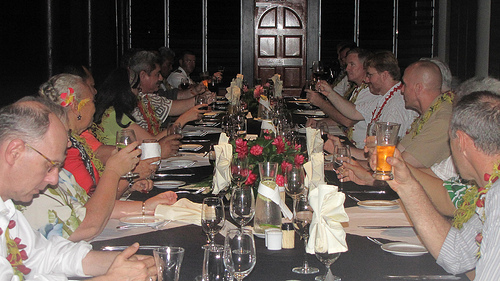Yesterday Secretary Clinton stepped down onto the tarmac at Nay Pyi Taw, marking the first visit to Burma by a US Secretary of State in more than half a century. Accompanying her are Assistant Secretary Kurt Campbell and a team of other Burma experts.
Today the Secretary met at length with Burmese President Thein Sein, his Foreign Minister, other senior Ministers, and the Speakers and Members of both houses of Parliament. In the Secretary’s words, “We had candid, productive conversations about the steps taken so far and the path ahead for reform.” A background briefing just posted online provides interesting insights on how the discussions went.
After meeting with President Thein Sein, Secretary Clinton engaged with Burmese reporters and other media to answer questions about the objectives and progress of her trip.
Although her 48 hours in Burma are packed with meetings, the Secretary fortunately had a few minutes today to visit the Shwedagon Pagoda, one of the great jewels of Southeast Asia. I spent an afternoon at Shwedagon in 1985, marveling at the architecture and dodging the tourist police.
Located on Singutarra Hill in Rangoon, parts of Shwedagon Pagoda, aka the Golden Pagoda, are more than 2,500 years old. Archaeologists believe that the original stupa was built during the lifetime of Siddhārtha Gautama Buddha, around 580BC.
The temple dominates the city’s skyline and has been a rallying point for civil protests since the 1920s. Over several days in September 2007, tens of thousands of monks, nuns, and other citizens marched at the Pagoda in protest against the military regime and in support of Aung San Suu Kyi.
The Secretary had a productive dinner this evening with Daw Aung San Suu Kyi, and will meet with her again tomorrow. While in Rangoon, the Secretary will also consult with a broad, diverse group of civil society and ethnic minority leaders about their views on developments in Burma.
Secretary Clinton’s visit is an historic opening, laden with promise. As she said earlier today:
“These are beginning steps, and we are prepared to go even further if reforms maintain momentum. In that spirit, we are discussing what it will take to upgrade diplomatic relations and exchange ambassadors. Over time, this could become an important channel to air concerns, monitor and support progress, and build trust on both sides.
“The last time an American Secretary of State came to Burma, it was John Foster Dulles, and this country was considered the jewel of Asia, a center of higher learning and the rice bowl of the region. In the last half century, other countries have raced ahead and turned East Asia into one of the world’s great centers of dynamic growth and opportunity. So the most consequential question facing this country, both leaders and citizens, is not your relationship with the United States or with any other nation. It is whether leaders will let their people live up to their God-given potential and claim their place at the heart of the 21st century, a Pacific century.
“There is no guarantee how that question will be answered. If the question is not answered in a positive way, then once again, the people could be left behind. But if it is answered in a positive way, I think the potential is unlimited.”
![]()
 RSS
RSS![NAY PYI TAW, Burma (November 30, 2011) Secretary of State Hillary Clinton arrives in Nay Pyi Taw to begin her historic visit to Burma. [State Department photo by Scott Weinhold] NAY PYI TAW, Burma (November 30, 2011) Secretary of State Hillary Clinton arrives in Nay Pyi Taw to begin her historic visit to Burma. [State Department photo by Scott Weinhold]](https://webarchive.library.unt.edu/web/20130312211602im_/http://farm8.staticflickr.com/7160/6430404679_036fa46608.jpg)
![Secretary of State Hillary Clinton is greeted by Burmese Deputy Foreign Minister Dr. Myo Myint as she arrives in Nay Pyi Taw to begin her historic visit to Burma. [State Department photo by Scott Weinhold] Secretary of State Hillary Clinton is greeted by Burmese Deputy Foreign Minister Dr. Myo Myint as she arrives in Nay Pyi Taw to begin her historic visit to Burma. [State Department photo by Scott Weinhold]](https://webarchive.library.unt.edu/web/20130312211602im_/http://farm8.staticflickr.com/7162/6430410587_f56248becf.jpg)
![Secretary of State Hillary Clinton visits Shwedagon Pagoda in Rangoon during her historic visit to Burma. [State Department photo by Kay Itoi] Secretary of State Hillary Clinton visits Shwedagon Pagoda in Rangoon during her historic visit to Burma. [State Department photo by Kay Itoi]](https://webarchive.library.unt.edu/web/20130312211602im_/http://farm8.staticflickr.com/7013/6437380771_e9e132f591.jpg)

![Secretary of State Hillary Clinton visits Shwedagon Pagoda in Rangoon during her historic visit to Burma. [State Department photo by Kay Itoi] Secretary of State Hillary Clinton visits Shwedagon Pagoda in Rangoon during her historic visit to Burma. [State Department photo by Kay Itoi]](https://webarchive.library.unt.edu/web/20130312211602im_/http://farm8.staticflickr.com/7019/6437445715_31081b1c18.jpg)
![Secretary of State Hillary Clinton meets Daw Aung San Suu Kyi for dinner in Rangoon during her historic visit to Burma. [State Department photo by William Ng] Secretary of State Hillary Clinton meets Daw Aung San Suu Kyi for dinner in Rangoon during her historic visit to Burma. [State Department photo by William Ng]](https://webarchive.library.unt.edu/web/20130312211602im_/http://farm8.staticflickr.com/7141/6437456379_0cc5f8a72e.jpg)








 View my Profile
View my Profile Connect with Wellington
Connect with Wellington Watch our Videos & Subscribe
Watch our Videos & Subscribe Watch our Videos on Vimeo
Watch our Videos on Vimeo Connect on GPlus
Connect on GPlus US Embassy NZ
US Embassy NZ


 Post Entries (RSS)
Post Entries (RSS)

